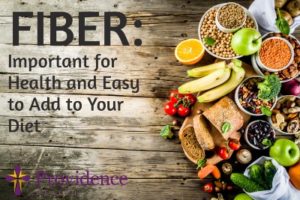Why Fiber is Important and How to Get More in Your Diet: Plus Pasta Primavera Recipe
August 11, 2019By Kay MacInnis, Registered Dietitian, Providence Health
Fiber is found in a wide variety of foods we eat, and is important to our digestive and cardiovascular systems. It helps lower cholesterol, stabilize blood sugar, and control our weight. A recent study published in the January 2019 Lancet found that, when compared to those who ate less fiber, participants who consumed between 25 – 29 grams of fiber a day had 15 – 30 percent less risk of: cardiovascular-related mortality, coronary heart disease, stroke, type 2 diabetes, and colorectal cancer. WOW! Sounds to me like we need to make sure we find ways to include more fiber into our diet.
There are two types of fiber and both are beneficial for your health. Insoluble fiber is fiber that takes longer to break down and helps create the sensation of being full after eating. It is found in fruits and vegetables with skins, whole grains like brown rice, whole wheat, buckwheat, oatmeal, nuts, seeds and dried fruits. Soluble fiber adds bulk to our digestion and is found in legumes, oatmeal, barley, bananas, and applesauce, for example. Soluble Fiber can help lower total LDL cholesterol and stabilize blood sugar.
Fruits, veggies, whole grains, beans, and lentils all contain fiber. The challenge is to eat these foods with as little processing as possible. When food is processed, even into something “healthy and whole” like granola bars or whole wheat pasta, it negatively impacts the fiber quality and content. The best way to ensure you are getting good fiber in your diet is to eat foods as close to their natural state as possible.
As important as it is to add fiber to the diet, it’s also important not to add too much fiber to your diet at one time to avoid gas, bloating, cramping and diarrhea. Add it slowly by making sure you’re eating a plant-based food close to its natural state with every meal. Also, choose recipes that include vegetables and use whole grains (which are naturally less processed). Then add fresh fruit, close to the form in which it comes picked, for dessert.
Healthy Pasta Primavera
- 2 c whole-grain penne pasta
- 1 tbsp olive oil
- ½ c chopped onion
- 1 lb fresh asparagus, trimmed and cut into2 inch pieces
- 1 small yellow summer squash, half lengthwise and sliced
- 2 c sliced fresh mushrooms
- 2 c cherry tomatoes, halved
- ½ c shredded carrot
- 2 cloves garlic, minced
- 1 tbsp chopped fresh oregano
- ½ tsp black pepper
- ¼ tsp salt
- ¼ tsp crushed red pepper
- ½ c freshly grated Parmesan cheese
- Lemon Wedges
Cook pasta according to package directions, drain. Heat oil in an extra-large skillet over medium-high heat. Add onion; cook until softened, 2 to 3 minutes. Add asparagus, mushrooms, and squash; cook until just tender, about 5 minutes. Add tomatoes, carrot, garlic, oregano, black pepper, salt and crushed red pepper; cook until tomatoes begin to soften, about 1 minute. Stir pasta and ¼ cheese into vegetable mixture. Top serving with remaining cheese and serve with lemon wedges
Nutrition information: 221 calories/per 1 2/3 c serving, 10 g fat, 10 g protein, 28 gm carbohydrate, 407 mg sodium
Recipe Source: Allrecipes Magazine, April/May 2019
Join Kay MacInnis, Registered Dietitian, for her monthly award-winning Providence Cooks! cooking classes in which she tackles various dietary hurdles by creating, with her team of chefs, a multi-course gourmet meal that promotes health and fits within dietary restrictions. All guests enjoy the healthy sit-down meal with live Q&A from Kay, the chefs, and other special health expert guests. It’s a must-try for people interested in healthy eating without losing the flavor and joy of eating.
Call 800.424.DOCS (3627) to learn about the next Providence Cooks! class.















